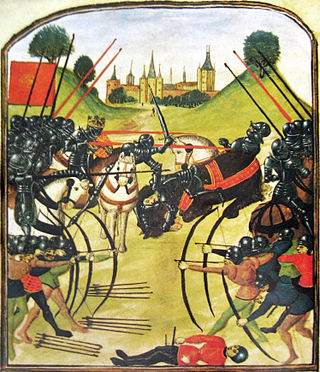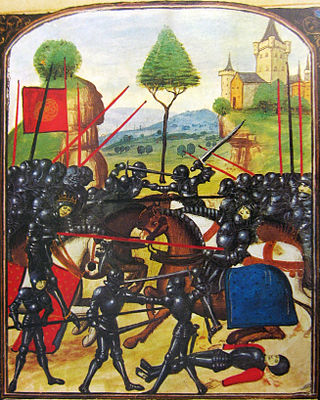
Edward IV was King of England from 4 March 1461 to 3 October 1470, then again from 11 April 1471 until his death in 1483. He was a central figure in the Wars of the Roses, a series of civil wars in England fought between the Yorkist and Lancastrian factions between 1455 and 1487.

Richard Neville, 16th Earl of Warwick, 6th Earl of Salisbury, known as Warwick the Kingmaker, was an English nobleman, administrator, landowner of the House of Neville fortune and military commander. The eldest son of Richard Neville, 5th Earl of Salisbury, he became Earl of Warwick through marriage, and was the wealthiest and most powerful English peer of his age, with political connections that went beyond the country's borders. One of the leaders in the Wars of the Roses, originally on the Yorkist side but later switching to the Lancastrian side, he was instrumental in the deposition of two kings, which led to his epithet of "Kingmaker".

The Battle of Tewkesbury, which took place on 4 May 1471, was one of the most decisive battles of the Wars of the Roses in England.

The Battle of Barnet was a decisive engagement in the Wars of the Roses, a dynastic conflict of 15th-century England. The military action, along with the subsequent Battle of Tewkesbury, secured the throne for Edward IV.

Edward of Westminster, also known as Edward of Lancaster, was the only son of Henry VI of England and Margaret of Anjou. He was killed aged seventeen at the Battle of Tewkesbury.
John Neville, 1st Marquess of Montagu was a major magnate of fifteenth-century England. He was a younger son of Richard Neville, 5th Earl of Salisbury, and the younger brother of Richard Neville, Earl of Warwick, the "Kingmaker".

The Battle of Edgcote took place on 24 July 1469, during the Wars of the Roses. It was fought between a royal army, commanded by the earls of Pembroke and Devon, and a rebel force led by supporters of the Earl of Warwick.

Empingham is a village in the county of Rutland in the East Midlands of England. The population of the civil parish was 815 at the 2001 census including Horn and increasing to 880 at the 2011 census. It lies close to the dam of Rutland Water and the A606 runs through the village. During construction, Empingham Reservoir was the name of the reservoir but it was renamed Rutland Water to preserve the name of the county which was being merged with Leicestershire.
Robert Welles, 8th Baron Willoughby de Eresby and 8th Baron Welles, was the son of Richard Welles, 7th Baron Welles, and Joan Willoughby, 7th Baroness Willoughby de Eresby. He was the prime mover in an uprising against Edward IV in 1470, although his actions were possibly orchestrated by Richard Neville, 16th Earl of Warwick.

Sir John Courtenay was the third son of Thomas Courtenay, 13th Earl of Devon, and Margaret Beaufort, and was styled Earl of Devon by Lancastrians in exile, following the execution of his brother the 14th earl in 1461.
Events from the 1460s in England.
Events from the 1470s in England.

Sir Humphrey Stafford, 1st Earl of Devon, 1st Baron Stafford of Southwick was a dominant magnate in South West England in the mid-15th century, and a participant in the Wars of the Roses. A distant relative of the Earls of Stafford, Humphrey Stafford became the greatest landowner in the county of Dorset through fortunes of inheritance. Later, Stafford was one of several men promoted rapidly through the nobility by King Edward IV, to fill the power vacuum left by dead or forfeit Lancastrians. In the West Country it was particularly the forfeitures of the Lancastrian Courtenay family that benefited Stafford. In 1469 he received the Courtenay title of Earl of Devon.

Bloody Oaks Quarry is a 1.3-hectare (3.2-acre) biological Site of Special Scientific Interest north-west of Great Casterton in Rutland. It is owned and managed by the Leicestershire and Rutland Wildlife Trust.
Richard Welles, 7th Baron Welles (c.1428–1470), was an English nobleman and soldier. From a Lancastrian family, he came to be on good terms with the Yorkist King Edward IV, but was later executed after being associated with a plot against Edward known as the "Welles Uprising".

The Readeption was the restoration of Henry VI of England to the throne of England in 1470. Edward, Duke of York, had taken the throne as Edward IV in 1461. Henry had fled with some Lancastrian supporters and spent much of the next few years in hiding in Northern England or in Scotland, where there was still some Lancastrian support. Henry was captured in 1465 and was held as a prisoner in the Tower of London. Following dissent with his former key supporter, Richard Neville, 16th Earl of Warwick, Edward was forced to flee in 1470. Henry was then restored to the throne, although he was deposed again the following year.

The Wars of the Roses (1455–1487), known at the time and for more than a century after as the Civil Wars, was a series of civil wars fought over control of the English throne in the mid-to-late fifteenth century. These wars were fought between supporters of two rival cadet branches of the royal House of Plantagenet: Lancaster and York. The wars extinguished the last male line of the House of Lancaster in 1471, leading to the Tudor family inheriting the Lancastrian claim to the throne. Following the war and the extinction of the last male line of the House of York in 1485, a politically arranged marriage united the Houses of Lancaster and York, creating a new royal dynasty which inherited the Yorkist claim as well, thereby resolving the conflict.
Robin of Redesdale, sometimes called "Robin Mend-All", was the leader of an insurrection against Edward IV of England. His true identity is unknown, but is thought to have been either Sir John Conyers, steward of Middleham, his brother Sir William Conyers of Marske, or both; the two were long-serving retainers of Richard Neville, Earl of Warwick. Graham Evans lists a number of other possibilities such as Sir John Conyers, the father of the previous Sir John and Sir William; Sir Richard Welles, who married Baroness Willoughby de Eresby; her son, Sir Robert Welles, 8th Baron Willoughby de Eresby; or Lord Robert Ogle, Warden of the East March and Lord of Redesdale.
Sir Henry Stafford was the second son of Humphrey Stafford, 1st Duke of Buckingham and Lady Anne Neville, daughter of Ralph de Neville, 1st Earl of Westmorland, and Lady Joan Beaufort. Henry's elder brother, also named Humphrey, died before their father, and so it was Henry's nephew, also Henry, who became the 2nd Duke of Buckingham.
Sir John Conyers, one of twenty-five children of Christopher Conyers, was a pre-eminent member of the gentry of Yorkshire, northern England, during the fifteenth century Wars of the Roses.














